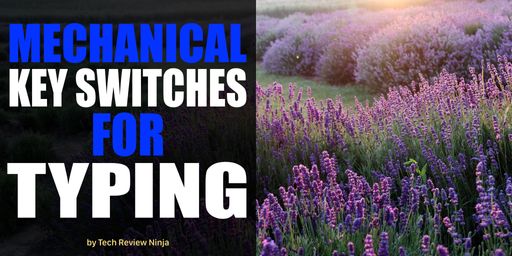
- What is a Mechanical Keyboard Key Switch?
- The Mechanical Key Switches Types
- The Best Key Switches for Typists
- Anatomy of a Mechanical Key Switch
- Key Switch Terminology
- Cherry MX
- Gateron
- Kailh
- Kailh Key Switches
- Kailh Brown
- Kailh Blue
- Kailh Box Key Switches
- Kailh Box Brown
- Kailh Box White
- Kailh Box Heavy Glazed Green
- Kailh Box Heavy Pale Blue
- Kailh Box Jade
- Kailh Box Noble Yellow
- Kailh Box Navy
- Kailh Box Heavy Blue
- Kailh Silent Key Switches
- Kailh Silent Brown
- Kailh Pro Key Switches
- Kailh Pro Purple
- Kailh Speed Key Switches
- Kailh Speed Copper
- Kailh Speed Bronze
- Kailh Speed Gold
- Zeal
- Conclusion
If you are also interested in reading about our recommendations for the best key switches for gaming keyboards, check out our previous article, What Mechanical Keyboard Key Switches are Best for Gaming?.
What is a Mechanical Keyboard Key Switch?
When choosing a pre-built mechanical keyboard you are sometimes offered multiple versions differing by a choice of the included key switch. For example, the popular DAS Keyboard 4 Professional is available with either the Cherry MX Brown or Blue switches. Each switch type has a slightly different feel and sound when used. Some have a tactile feel and are relatively quiet, where others have a loud click noise (some very loud!) Some keyboards even allow you to swap out the key switches, called a hot-swappable keyboard. For example, I use the Glorious GMMK Tenkeyless keyboard that includes the Gateron Brown key switches as standard; however, the keyboard has been designed to allow the key switches to be easily removed and swapped out. This allows you to upgrade the feel of your keyboard as your needs change, or you simply want something different without the expense of a new keyboard. A set of key switches is also relatively inexpensive (USD 30 to 40), which can effectively give you a completely different keyboard experience.
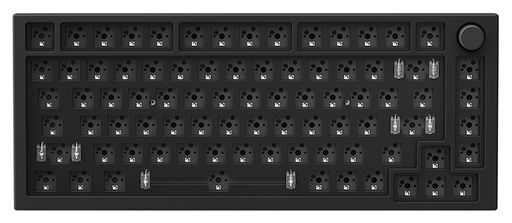
Choosing a pre-built keyboard or choosing to upgrade the key switches of an existing hot-swappable board requires you to decide on the type and feel of the key switches. If you are a typist or if typing is your primary use for a keyboard, specific styles of key switches are favoured over others.

I have included key switches that are compatible with the Cherry MX standard, making them suitable for most hot-swappable keyboards.
The Mechanical Key Switches Types
The primary reason for choosing a mechanical keyboard is due to the use of a mechanical key switch rather than other switch technologies such as a membrane or scissor keyboards. Mechanical keyboards are very popular with typists due to their tactile switches and high build quality. There is quite a lot of variation in feel and sounds between the available key switches, but they all fall into 3 main categories.
- Linear - A linear key switch has a smooth and consistent feel throughout the keystroke. They are preferred by gamers but less so by typists who like to 'feel' the keypress more, resulting in faster typing speeds.
- Tactile - A tactile key switch has a tactile bump partway through the keystroke. For some switches, this is felt at the start of the key travel, for others it is felt further down. The bump signifies that the key has registered the press and that you do not need to continue to press the key. This is unlike a linear switch where you are not aware of the point the keypress is registered. Tactile key switches are favoured by typists as it means they do not have to fully depress the key resulting in faster typing speeds. Some switches, such as the tactile Gateron Brown, the bump is very subtle and hard to notice. Others, such as the Cherry MX or Kailh Box Brown have a more noticeable bump.
- Clicky - A clicky keyboard is one that you may first think about when you consider a mechanical keyboard. They closely resemble the typing experience of a typewriter, providing a stronger tactile bump as well as a loud click at the point the keypress is registered. Many clicky key switches feature 2 clicks, a more prominent and loud click on the key downstroke and a lighter click on the upstroke. This loud noise is also what makes a clicky mechanical keyboard less appealing to those in open or office environments.
The Best Key Switches for Typists
When choosing a mechanical keyboard, typists usually prefer a key switch that has a tactile feel when you depress the key. This gives noticeable feedback to represent a successful keypress. Some also favour a loud clicky sound that provides audible feedback. All clicky key switches are also tactile.
I have split the recommendations between tactile and clicky key switches. I do not recommend linear switches for fast typing as without the tactile feedback you tend to depress the switch more and it may bottom out. This can result in finger fatigue and also slow down your typing rate.
Tactile Key Switches
A tactile key switch would be my first choice for typing. Whilst not offering the audible feedback of a clicky switch, the loud noise of a clicky switch can mean they are less suited to an office or open environment. Tactile switches are also very popular, therefore there is a wide choice available.
Runner Up - Cherry MX Brown - The go-to tactile switch by several keyboard manufacturers. Less of a tactile bump than the Kailh Box Brown, but more defined than the Gateron Brown. If you want a slightly stronger feel then look at the Cherry MX Clear. However, they can be hard to find, especially on pre-built keyboards.
Runner Up - Zealios V2 - These are loved due to having one of the strongest tactile bumps of all tactile key switches. I especially enjoy the 67g switch, having a fantastic crisp and responsive feel. However, they do come with a word of caution. As they are PCB-mount switches (meaning they are expected to be soldered to a PCB), they are not plug-and-play compatible with many plate mount keyboards that only have a single hole without trimming 2 of the plastic legs. If you are a keyboard enthusiast this is no big deal, but for some, you might not be comfortable trimming them. Also, note that these are more expensive than other switches.
Runner Up - Gateron Brown - Whilst I have used Gateron Brown switches for several years, their weaker tactile bump does mean they can feel more like a linear switch.
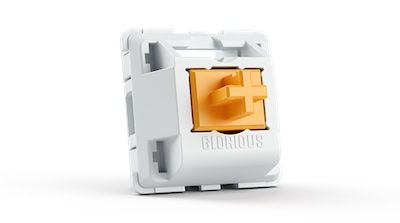
You can read more about the Glorious Panda tactile key switches at the Glorious website.
Clicky Key Switches
A clicky key switch is the type of switch you first think about when thinking of typists. The substantial tactile bump and loud clicky noise give a retro typewriter feel and sound. One word of caution. Some clicky key switches are very loud. You need to be aware of the environment where you will be typing.
Runner Up - Kailh Box Jade - These include a thicker click bar that gives them a slightly stronger feel and is slightly louder than the Kailh Box White. A great alternative to the Box White.
Runner Up - Cherry MX Blue - The go-to clicky switch included by several keyboard manufacturers. Still a great switch, but I think the Kailh has a slightly better feel and sound.
Anatomy of a Mechanical Key Switch
A mechanical key switch is made from only 5 parts. They are made from high precision plastic polymer with a gold-plated internal switch to ensure minimal wear and achieve a long lifespan. Many switches are rated to last between 50 million and 100 million key presses.
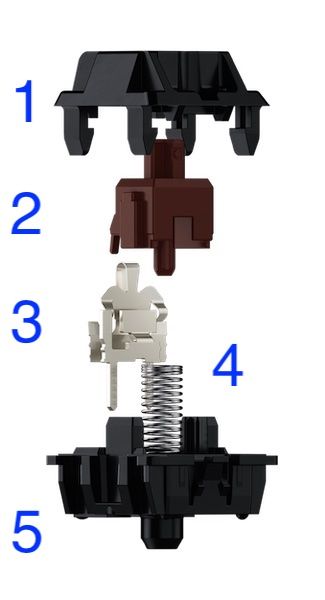
1) Upper Housing - The upper housing is made from a plastic polymer to a very high level of tolerance, guiding the stem to create a smooth vertical movement with a negligible wobble. You will notice that with very cheap keyboards, the keys feel very unstable when typing due to lower tolerances.
2) Stem - The stem is made of plastic polymer that creates vertical movement and the key feel. For a tactile or clicky key switch, the stem is responsible for the tactile or clicky characteristics due to its unique shape and design. The stem is also the part that is coloured as per the switch name.
3) Crosspoint Contact - Usually gold-plated, the crosspoint contact is the heart of the key switch. Using gold ensures there is no corrosion throughout the life of the switch.
4) Coil Spring - The coil spring provides the resistance you feel when you depress the key. Each switch type uses a different rated spring. You can see the effect of the spring when looking at the activation and bottom-out force values for each switch.
5) Base Housing - Like the upper housing, the base housing is made from a plastic polymer. The base housing both holds together the switch internal mechanism and also forms the mount with which it connects to the keyboard base.
Key Switch Terminology
There are several terms used when comparing the specifications of a mechanical key switch.
- Activation Force - measured in grams (g) and represents the force that needs to be applied to activate the switch. A lower number gives the keyboard a lighter feel; however, you may find that these switches are activated too easily. The higher the number the harder the keys will feel. A gamer or typist prefers a balance as too high an activation force can result in finger fatigue over time.
- Bottom Out Force - measured in grams (g) and represents the force that needs to be applied to fully bottom out the switch. Many switches have a similar activation and bottom-out force resulting in a smooth resistance throughout the keystroke. If the bottom-out force is higher than the activation force the switch will feel progressively harder to press throughout the keystroke.
- Activation - measured in mm and represents the distance the key switch needs to travel before it is activated. Too little can result in keys being incorrectly activated if you are a fast typist and too high can make typing speeds slower as you need to depress each key further. Note that there is always a tolerance of around 0.6mm in these values. Some switches designed for gamers offered a reduced activation resulting in a faster response time.
- Travel - measured in mm and represents the total travel of the key switch. Most mechanical key switches have a travel of around 4mm, with some slim keyboards having reduced travel. Note that there is always a tolerance of around 0.6mm in these values. Some switches designed for gamers offered reduced travel resulting in a faster response time.
Key Switch IP Rating
Many key switches will offer an IP rating in their specifications for dust and moisture protection. For example, Cherry MX switches are rated at IP40 and Kailh at IP56. I have not been able to find any ratings specific to Gateron switches; however, would assume they are also IP40 as they closely follow the Cherry MX design. You may see a similar rating for mobile phones and smartwatches, such as the iPhone that specifies a rating of IP68. So, what do these ratings mean?
IP stands for Ingress Protection, with the IP rating number being split into 2 digits, with the first digit representing the solid protection and the second digit the liquid protection.
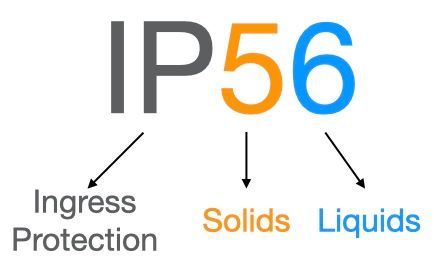
- IP40 - This rating covers most Cherry MX switches, with a solid protection rating of 4, meaning protection against solid objects larger than 1mm and a liquid protection rating of 0, meaning no rating or protection.
- IP56 - This rating covers most Kailh switches, with a solid protection rating of 5, meaning partial protection against dust and other particulates and a liquid protection rating of 6, meaning protection against powerful jets of directed water from any direction.
Even though this seems to show that Kailh is a clear winner, I would not personally read too much into this. If you do accidentally spill water onto your keyboard, I suspect the rest of the keyboard would not be that waterproof and also suffer damage. I have never had a key switch fail, but I did find it interesting to understand what these ratings mean.
Cherry MX
Cherry is based in Auerbach, Germany and has been manufacturing electrical and computer input devices since being formed in 1953 by Walter Cherry. They are responsible for the design of the original Cherry MX key switch first released in 1983. Ever since the Cherry patents for the MX switch design expired in 2014 several alternative manufacturers have entered the market with similar (and in many cases identical) designs. There were several features of the original patents, such as the self-cleaning mechanism that helped differentiate them from other styles of key switches and helped it become a world-leading key switch design. Cherry state that they have sold over 6 billion key switches and feature in more than 60 million keyboards worldwide.
Cherry MX switches are still engineering and manufactured in Germany to this day.
The Cherry MX Brown is rated for 100 million activations (other Cherry MX switches are 50 million) and all Cherry MX key switches are IP40 rated for dust and moisture resistance.
| Key Switch | Style | Activation Force | Activation | Travel |
|---|---|---|---|---|
| Cherry MX Brown | Tactile | 55g | 2mm | 4mm |
| Cherry MX Clear | Tactile | 65g | 2mm | 4mm |
| Cherry MX Grey | Tactile | 80g | 2mm | 4mm |
| Cherry MX Blue | Clicky | 60g | 2.2mm | 4mm |
| Cherry MX Green | Clicky | 80g | 2.2mm | 4mm |
Cherry MX switches come in either a standard MX or an MX RGB design that is optimised for use with SMD LEDs. All images show the MX RGB variant.
Cherry MX switches are used by many manufactures of mechanical keyboards. I rate DAS Keyboards as producing some of the best mechanical keyboards you can buy for typing. Das Keyboard sponsors the international Ultimate Typing Championship for good reason. They make some of the best mechanical keyboards for typing. The solid and robust design, combined with quality Cherry MX key switches makes them ideal for typists looking to improve their typing accuracy and speed.
Cherry MX Brown
Often referred to as the original tactile mechanical key switch, the Cherry MX Brown is the most popular Cherry MX tactile switch and is the go-to tactile switch for many keyboard manufacturers. It features a well defined tactile bump, a smooth feel and a medium activation force of 55g. The Cherry MX Brown is rated for 100 million activations.
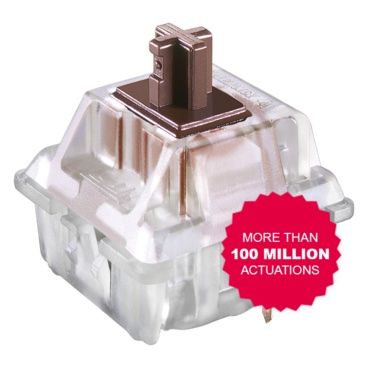
- Switch Type - Tactile
- Activation Force - 55g
- Bottom Out Force - 60g
- Activation - 2mm
- Travel - 4mm
Keyboards popular with typists such as the DAS Keyboard 4 Professional are available with Cherry MX Brown switches.
If you require a more substantial tactile bump with a higher activation and bottom-out force, the Cherry MX Clears may be a better fit.
Cherry MX Clear
Cherry MX Browns are sometimes said to be a bit weak, so the MX Clears provide a more substantial feel. The required activation force is slightly higher than MX Brown at 65g compared to 55g. However, the bottom-out force is considerably higher at 95g. Whilst this is preferred by typists who tend to not bottom out their keys, heavier typists might mind this too high and may result in finger fatigue.
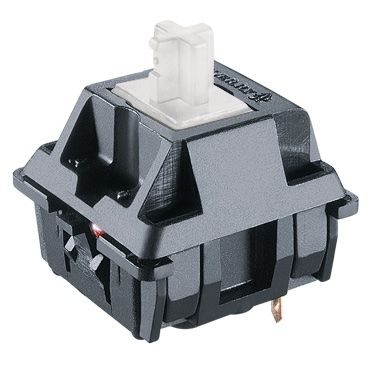
- Switch Type - Tactile
- Activation Force - 65g
- Bottom Out Force - 95g
- Activation - 2mm
- Travel - 4mm
The Cherry MX Clear is rated for 50 million activations, half that of the MX Brown.
Note that these switches are not that easy to find and are typically not included with pre-built keyboards. One exception is the excellent keyboards from WASD Keyboards, available in either 104-key full-size or 87-key Tenkeyless.
For those building a custom keyboard with Cherry MX switches, the MX Clear is sometimes used as the space bar with other keys using MX Brown switches. A benefit of custom hot-swappable keyboards is the ability to install specific key switches where needed.
Cherry MX Grey
Another variation of the Cherry MX Brown with an even higher force is required to activate and bottom out the switch. MX Browns are sometimes said to be quite weak, so these provide a more solid feel than either the MX Brown or MX Clears. However, the force is nearly double the MX Brown and even higher than the MX Clears, so I recommend testing these out first, as they require too much force to press for the majority of people.
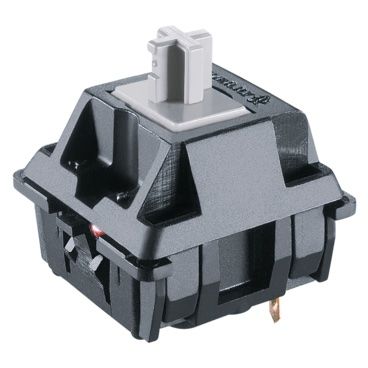
- Switch Type - Tactile
- Activation Force - 80g
- Bottom Out Force - 105g
- Activation - 2mm
- Travel - 4mm
The Cherry MX Grey is rated for 50 million activations, half that of the MX Brown.
Cherry MX Blue
The Cherry MX Blue is one of the most popular Cherry MX switches and is the go-to clicky switch. The Cherry MX Blue is rated for 50 million activations, half that of the MX Brown. The MX Blue has a reassuring tactile feel when activated. The clicky noise, whilst significantly louder than a tactile keyboard, does not sound too sharp or rattly, making for a pleasant background clatter when typing. Some clicky key switches are simply too loud and rattly. The Cherry MX Blue finds a nice middle ground.
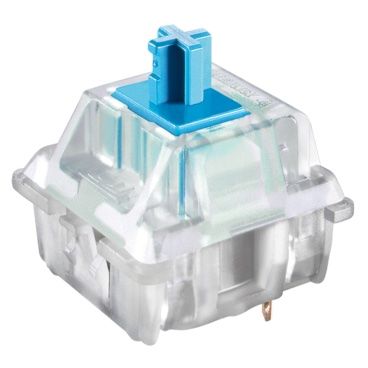
- Switch Type - Clicky
- Activation Force - 60g
- Bottom Out Force - 60g
- Activation - 2.2mm
- Travel - 4mm
Keyboards popular with typists such as the DAS Keyboard 4 Professional are available with Cherry MX Blue switches.
Cherry MX Green
The Cherry MX Green requires more force to activate than the MX Blue, 80g over 60g. The clicky noise is more rattly sounding than the MX Blues and can be distracting when typing fast. I also found the higher bottom-out force felt unpleasant when typing, even though they do offer a very retro typewriter feel and sound. This can mean a higher chance of finger fatigue over long typing sessions.
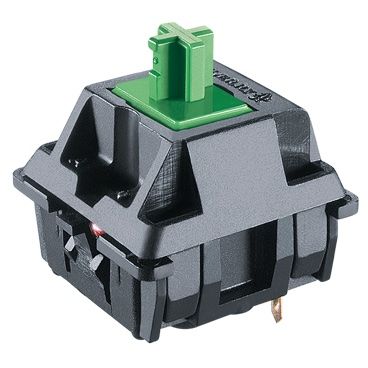
- Switch Type - Clicky
- Activation Force - 80g
- Bottom Out Force - 90g
- Activation - 2.2mm
- Travel - 4mm
The Cherry MX Green is rated for 50 million activations, half that of the MX Brown.
Gateron
Ever since Cherry's patents on the MX switches expired in 2014, the market has been flooded with inexpensive clones of their key switches. Many of these are of poor quality; however, a few companies such as Gateron and Kailh have grown to offer switches that match and in many cases better the Cherry equivalents.
Gateron is a Chinese manufacturing company that is located in Guangdong and has been manufacturing electrical key switches since 2000. They specialise in the development and production of electronic and electrical switches, sensors, and plastic hardware parts.
Gateron Key Switches
Most clone key switches are named and coloured according to their corresponding Cherry MX counterpart. Whilst they are designed from the original Cherry patents and imitate the Cherry MX switch feel, they are not always identical to their Cherry counterparts. Gateron is well known for producing a smoother switch than Cherry MX, especially their linear switches.
Gateron key switches are available with either solid or clear shells. The clear shells are popular if you use an RGB keyboard where the LED lighting shines through the key switches due to the RGB lights being mounted underneath the key switches. A solid key switch blocks a lot of the light.
The quality of Gateron key switches is very high, and have a typical minimum of 50 million switch activations. I have not had a Gateron switch fail, and I have been using Gateron switches for several years.
| Key Switch | Style | Activation Force | Activation | Travel |
|---|---|---|---|---|
| Gateron Brown | Tactile | 55g | 2mm | 4mm |
| Gateron Blue | Clicky | 60g | 2mm | 4mm |
| Gateron Green | Clicky | 80g | 2mm | 4mm |
Gateron makes some great linear switches, but their tactile and clicky switches are simply not as good as those from Cherry or Kailh. You can check out our articles Gateron Mechanical Keyboard MX Key Switch Guide and What Mechanical Keyboard Key Switches are Best for Gaming? for our opinions of Gateron key switches.
Gateron Brown
The Gateron Brown, whilst offering a pleasantly smooth response also has a weaker tactile feel than either the Cherry MX Brown or Kailh Box Brown. Many say that they feel more like a linear switch rather than tactile due to the lack of a clear tactile bump. I tend to agree, and fans of tactile switches may not be happy with the relatively poor tactile response.
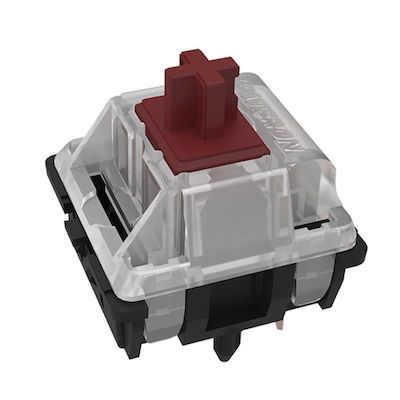
- Switch Type - Tactile
- Activation Force - 55g
- Bottom Out Force - 65g
- Activation - 2mm
- Travel - 4mm
I was previously a big fan of Gateron Browns, but after using tactile and clicky switches from Kailh, especially the Kailh Box switches, I am starting to recommend Gateron less for either tactile or clicky switches.
Gateron Blue
The Gateron Blue key switch has a similar feel to the Cherry MX Blue and Kailh Box White, but have an inferior tactile feel and sound.
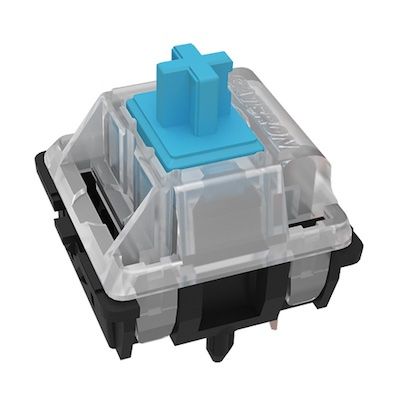
- Switch Type - Clicky
- Activation Force - 60g
- Bottom Out Force - 65g
- Activation - 2mm
- Travel - 4mm
Gateron Green
The Gateron Green requires a higher activation force of 80g over the Gateron Blue at 60g. Whilst this does give them a very retro typewriter feel and a solid click sound, it can also cause finger fatigue over long typing sessions.
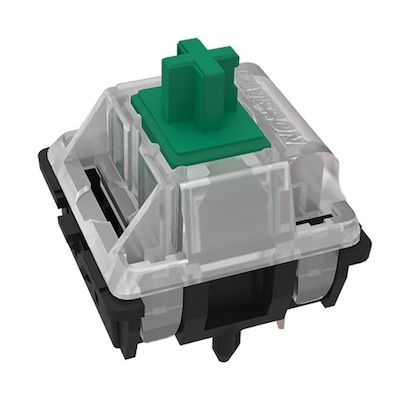
- Switch Type - Clicky
- Activation Force - 80g
- Bottom Out Force - 80g
- Activation - 2mm
- Travel - 4mm
Kailh
Kailh, or officially Dongguan Kaihua Electronics was founded in 1990. They specialise in electronic and electric switches. Whilst Kailh do manufacture clones of the original Cherry MX design, they have also developed several unique designs themselves, such as with their Box design.
Kailh Key Switches
These are the most basic Kailh switches and closely resemble the corresponding Cherry MX or Gateron switches. I would recommend you look beyond these in favour of the Kailh Box switches. The box design offers a smoother feel with less keycap wobble due to the design of the stem.
| Key Switch | Style | Activation Force | Activation | Travel |
|---|---|---|---|---|
| Kailh Brown | Tactile | 50g | 1.9mm | 4mm |
| Kailh Box Brown | Tactile | 50g | 1.8mm | 3.6mm |
| Kailh Silent Brown | Tactile | 45g | 1.8mm | 3.6mm |
| Kailh Pro Purple | Tactile | 50g | 1.7mm | 3.6mm |
| Kailh Speed Copper | Tactile | 50g | 1.1mm | 3.5mm |
| Kailh Blue | Clicky | 50g | 1.9mm | 4mm |
| Kailh Box White | Clicky | 50g | 1.8mm | 3.6mm |
| Kailh Box Heavy Glazed Green | Clicky | 50g | 1.8mm | 3.6mm |
| Kailh Box Heavy Pale Blue | Clicky | 60g | 1.8mm | 3.6mm |
| Kailh Box Jade | Clicky | 50g | 1.8mm | 3.6mm |
| Kailh Box Noble Yellow | Clicky | 65g | 1.8mm | 3.6mm |
| Kailh Box Navy | Clicky | 75g | 1.8mm | 3.6mm |
| Kailh Box Heavy Blue | Clicky | 95g | 1.8mm | 3.6mm |
| Kailh Speed Bronze | Clicky | 50g | 1.1mm | 3.5mm |
| Kailh Speed Gold | Clicky | 50g | 1.4mm | 3.5mm |
All Kailh key switches feature a 50 million actuation lifetime.
Kailh Brown
The Kailh Brown is non-RGB and is not as good as switches from Cherry MX or Gateron with a slightly scratchy feel. I recommend the Kailh Box Brown instead.

- Switch Type - Tactile
- Activation Force - 50g
- Bottom Out Force - 60g
- Activation - 1.9mm
- Travel - 4mm
Kailh Blue
The Kailh Blue is non-RGB and is not as good as switches from Cherry or Gateron and has a slightly scratchy feel. I recommend the Kailh Box White instead.
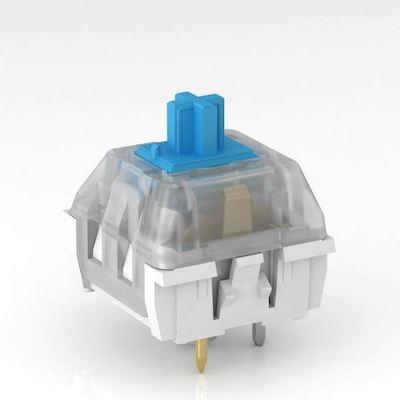
- Switch Type - Clicky
- Activation Force - 50g
- Bottom Out Force - 60g
- Activation - 1.9mm
- Travel - 4mm
Kailh Box Key Switches
These switches feature a unique box design to the stem. This keeps the stem protected to provide an IP56 rating for dust and moisture and also reduces any keycap wobble.
Note that the Kailh Box key switches are only compatible with SMD LEDs rather than the through-hole LEDs due to the IP56 water-resistant construction. They have slightly less travel (3.6mm) and activation (1.8mm) than standard MX switches (typically 4mm and 2mm respectively.) The design includes a hole on the bottom of the switch, meaning that they cannot be easily lubed without the chance of lube leaking out.
All Kailh Box key switches feature an 80 million actuation lifetime.
Kailh has released such a large number of Box switches, especially the clicky variety, that it can be hard to differentiate between many of them. In addition, Kailh also has several collaborations with mechanical keyboard specialists such as NovelKeys that result in even more variations.
Kailh Box Brown
The Kailh Box Brown is a fantastic tactile switch. It has a firmer tactile bump than the Gateron Brown and is smoother than either the Gateron or Cherry MX Brown.
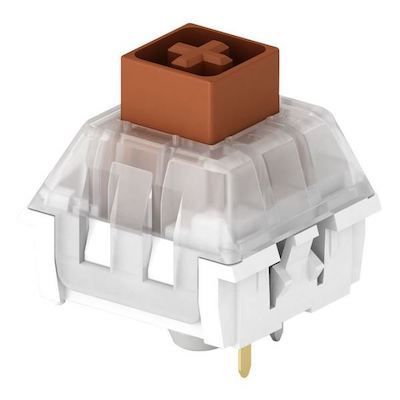
- Switch Type - Tactile
- Activation Force - 50g
- Bottom Out Force - 60g
- Activation - 1.8mm
- Travel - 3.6mm
Kailh Box White
The Kailh Box White features a click bar design and makes it a fantastic clicky switch. Cherry MX switches feature a click jacket design, and the general opinion seems to favour the click bar design. The click bar results in a nice crisp double-click sound. It is a smooth sounding click and with a medium activation and bottom-out force is a pleasure to type on.

- Switch Type - Clicky
- Activation Force - 50g
- Bottom Out Force - 60g
- Activation - 1.8mm
- Travel - 3.6mm
Kailh Box Heavy Glazed Green
Released in 2019, the Glazed Green is a recent addition to the Kailh Box range of switches.
A member of the ‘heavy’ series, and like the Heavy Pale Blue switch, these have a progressively heavier feel towards the end of the key travel due to the spring design. The low bottom-out force in the specifications can be deceptive as they feel heavier than the Box White that, on paper, should be heavier. This is one reason I recommend trying out several key switches before. Cheap key switch testers are available on eBay.
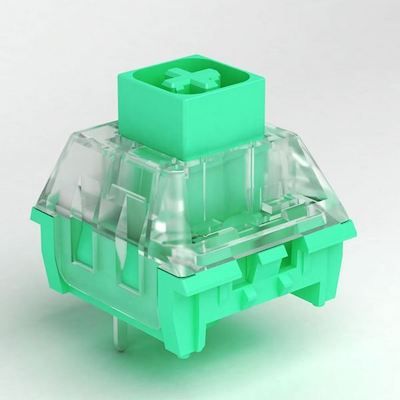
- Switch Type - Clicky
- Activation Force - 50g
- Bottom Out Force - 50g
- Activation - 1.8mm
- Travel - 3.6mm
Kailh Box Heavy Pale Blue
These have a slightly heavier activation force than the Box White. Interestingly they feel heavier than the 60g specification. This is because whilst the activation force is 60g, the bottoming out force is 80g. Many switches only have a 0g to 10g higher bottoming out force, providing a pretty consistent feel across the keystroke. The Box Heavy switches feel progressively heavier towards the end of the key travel. This gives a sharper click feeling, offering a more satisfying feel when typing.
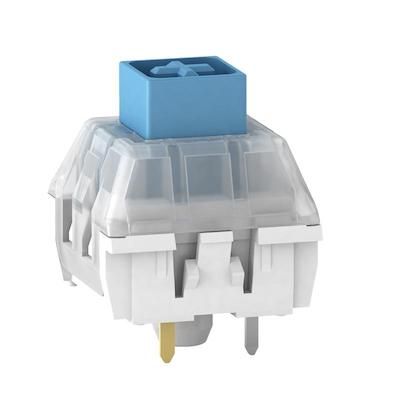
- Switch Type - Clicky
- Activation Force - 60g
- Bottom Out Force - 80g
- Activation - 1.8mm
- Travel - 3.6mm
Kailh Box Jade
The Kail Box Jade features a thicker click bar than the Box White resulting in a louder sound than other Box switches. The click bar results in a nice crisp double-click sound. They have a similar feel to the Kailh Box White.
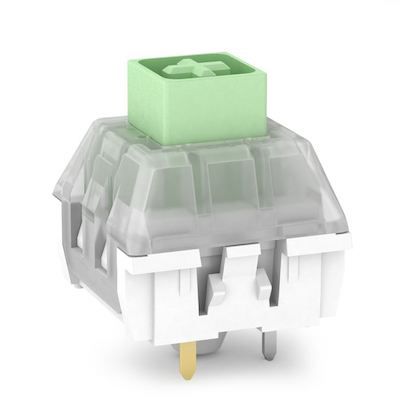
- Switch Type - Clicky
- Activation Force - 50g
- Bottom Out Force - 60g
- Activation - 1.8mm
- Travel - 3.6mm
Kailh Box Noble Yellow
Released in 2019, the Noble Yellow is a recent addition to the Kailh Box range of switches.
Even though they have a smooth feel and a nice tactile bump, they do not sound as good as either the Box White or Box Jade and have a slightly rattly metallic sound.
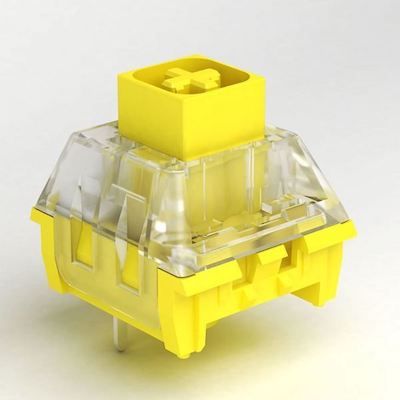
- Switch Type - Clicky
- Activation Force - 65g
- Bottom Out Force - 65g
- Activation - 1.8mm
- Travel - 3.6mm
Kailh Box Navy
Similar to the Kailh Box Jade, these feature a thicker click bar to produce a louder sound. They have a slightly heavier feel to the Box White. As the activation and bottom-out force is the same, they have quite a linear feel when pressed, without an increase or decrease in feel throughout the keypress.
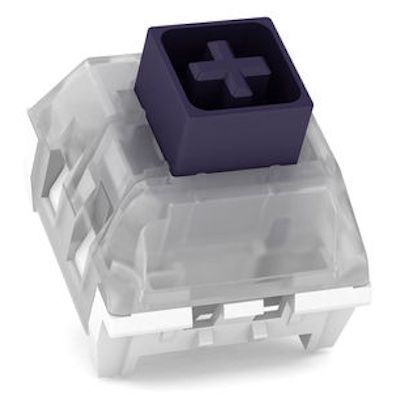
- Switch Type - Clicky
- Activation Force - 75g
- Bottom Out Force - 75g
- Activation - 1.8mm
- Travel - 3.6mm
Kailh Box Heavy Blue
Even though they are called blue, the stem is a dark grey colour. I guess Kailh are running out of names considering they have released so many switches! Keeping to their name, they have a very heavy activation and bottom-out force. I found these too heavy for fast typing.

- Switch Type - Clicky
- Activation Force - 95g
- Bottom Out Force - 100g
- Activation - 1.8mm
- Travel - 3.6mm
Kailh Silent Key Switches
Similar to the Cherry MX Silent switches, these are designed to offer the same feel as their equivalent switches but with a quieter sound.
Kailh Silent Brown
Whilst these have a lower sound they also have a lower tactile bump which is disappointing. They feel similar to the Gateron Brown that also has a low tactile feel.

- Switch Type - Tactile
- Activation Force - 45g
- Bottom Out Force - 65g
- Activation - 1.8mm
- Travel - 3.6mm
With a similar internal design to the Cherry MX Silent Red, the switch includes a rubber dampener to reduce noise when they bottom out. Unlike Kailh Box switches, these feature a stem that is a circular shape rather than a box. This did not seem to introduce any more or less keycap wobble.
Kailh Pro Key Switches
The Kailh Pro range of switches is listed as Kailh’s more professional and higher-end models. They do not feature the Kailh Box design and I found they do have slightly more keycap wobble.
Kailh Pro Purple
Even though these are Pro switches, I did not find them to be as smooth as the Box or Speed switches. They have quite a wobbly feel, especially compared to the Kailh Box switches. They have a good tactile bump right at the start of the key press and feel more linear for the rest of the key travel. They have a stiffer spring towards the end of the keystroke, similar in feel to the Kailh Heavy switches and are quite difficult to bottom out. One thing I do like with the Pro Purple is the sound. They have a nice reassuring thud when pressed, a richer sound than the Box Brown. They have often been labelled a poor cousin to Zealios switches, especially the 65g and 67g versions. I prefer to think of them as having a unique feel. If you are a light typist and do not regularly bottom out your keys, these are a fantastic switch. If you are a heavy typer you may not enjoy their feel when they bottom out.
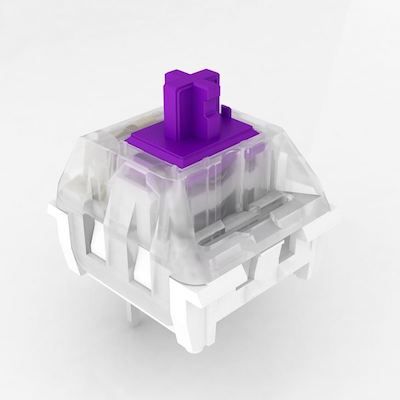
- Switch Type - Tactile
- Activation Force - 50g
- Bottom Out Force - 70g
- Activation - 1.7mm
- Travel - 3.6mm
I prefer the Kailh Box switches over the Pro switches for typing feel and response.
Kailh Speed Key Switches
Similar to the Cherry MX Speed switches, these are designed with a higher activation point of only 1.1mm compared to 2.2mm of other Kailh switches.
Kailh Speed Copper
Similar in feel to the Box Brown. They do not feature the box design so there is a slight bit of keycap wobble.

- Switch Type - Tactile
- Activation Force - 50g
- Bottom Out Force - 60g
- Activation - 1.1mm
- Travel - 3.5mm
Kailh Speed Bronze
Similar in feel to the Box White. However, they feature a click jacket design that means the click does not sound as crisp as the click bar designs. Therefore I prefer the Kailh Box White or Box Jade. They do not feature the box design so there is a slight bit of keycap wobble.
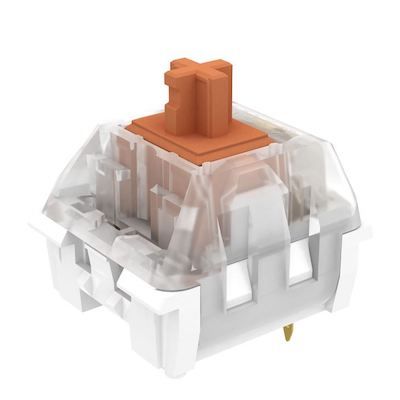
- Switch Type - Clicky
- Activation Force - 50g
- Bottom Out Force - 65g
- Activation - 1.1mm
- Travel - 3.5mm
Kailh Speed Gold
Similar in feel to the Box White. However, they feature a click jacket design that means the click does not sound as crisp as the click bar designs. Therefore I prefer the Kailh Box White or Box Jade. They do not feature the box design so there is a slight bit of keycap wobble. They have slightly more activation travel than the Speed Bronze, somewhat halfway between the Speed Bronze and the Box Brown.
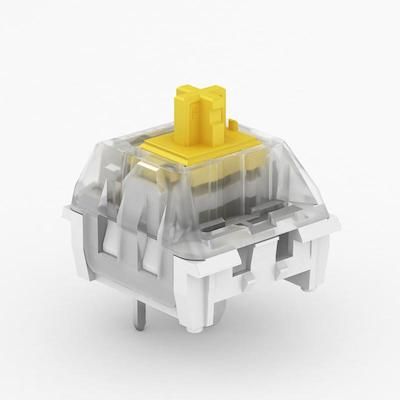
- Switch Type - Clicky
- Activation Force - 50 g
- Bottom Out Force - 60g
- Activation - 1.4mm
- Travel - 3.5mm
Zeal
Zeal is a specialist keyboard component company that was started by a group of mechanical keyboard enthusiasts. Zealios V2s are the product of a collaboration between Zeal and Gateron.
Zealios V2 Tactile Switch
Zealios v2 are probably some of the most tactile switches on the market, so if you're interested in a switch being very tactile, they're a good choice.
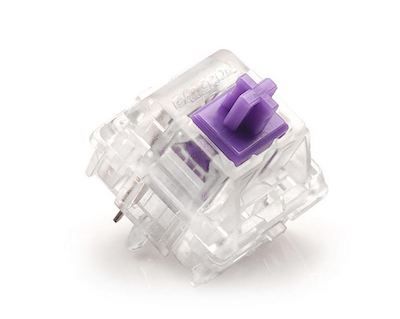
- Switch Type - Tactile
- Bottom Out Force - 62g, 65g, 67g or 78g
- Activation - 2mm
- Travel - 4mm
Unlike other key switches, Zeal does not specify an activation force, rather they are differentiated by their bottom-out force.
- 62g - These have a smooth, crisp and light feel, being slightly heavier than the Cherry MX Browns in weight.
- 65g - These have a smooth, long, drawn-out tactile bump. They are nicely cushioned when they bottom out feeling similar to a switch that includes an o-ring.
- 67g - These have a slightly more crisp & responsive tactile bump feeling at the very top of the keystroke and with more cushion during bottom out than the 65g switch.
- 78g - These have a slightly lighter feel than the Cherry MX Clear, but with a bigger and smoother bump than Cherry MX Clears. The spring is heavier than all other Zealio V2 switches.
Conclusion
Being able to choose between key switches is a great advantage of choosing a mechanical keyboard or building your custom keyboard. There is a variety of switches available that are either aimed at or are better for typists and typing. Both tactile and clicky key switches offer a great typing experience.
I always recommend trying out key switches where possible as it can be quite hard to decide upon your preferred switch with just a subjective set of technical data. There are many key switch sound tests on YouTube that might help in your choice, but the sound is only one factor to consider.
Key Switches Samples
To help you decide, I recommend getting an inexpensive key switch sample set that includes several key switches to test. There is a number available on eBay, but my favourite is the Glorious Switch Sample Pack which contains 14 of the most popular switches from Gateron and Kailh.
- Gateron Switches - Black, Blue, Brown, Clear, Green, and Red
- Kailh Switches - Box Black, Box Brown, Box Red, Box White, Speed Bronze, Speed Copper, Speed Silver, and Pro Purple
- Glorious O-Rings - both thin and thick are included
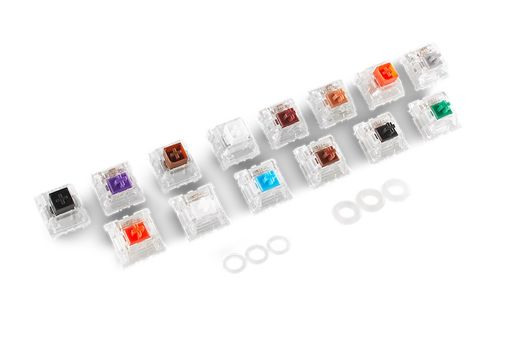
The included O-Rings can be added to key switches to dampen the feel and sound when the switch bottoms out when fully depressed. These can be popular if you are on conference calls or streaming, and you want to reduce the ambient noise, but still retain the feel of the key switch.
